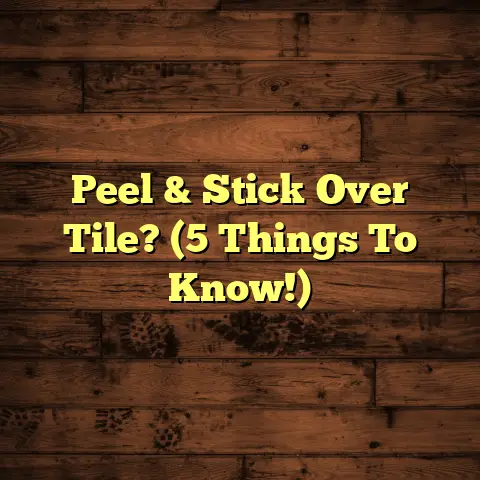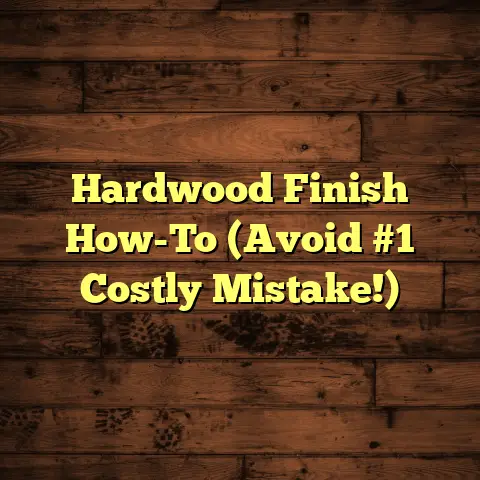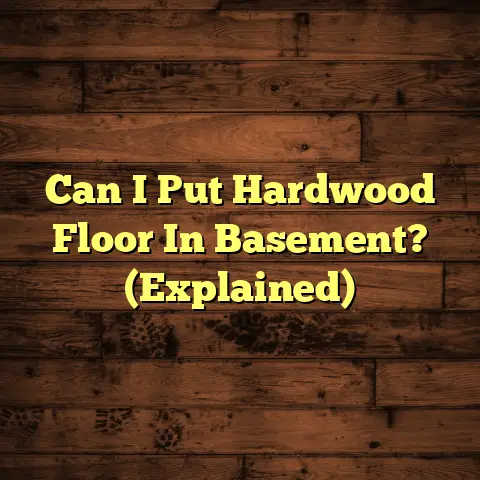Can You Replace Just Some Floorboards? (3 Steps!)
Ever stared at a single, rogue floorboard – maybe it’s warped, cracked, or just plain ugly – and wondered if you’re doomed to replace the entire floor? I get it. It’s a daunting thought, right?
Well, good news! In many cases, you can replace just a few floorboards, saving you a ton of time, money, and hassle. Let’s dive into how it’s done!
Section 1: Understanding Floorboard Damage
First, we need to talk about what kind of floor you have and what’s going on with it. Not all floorboards are created equal, and the type of damage matters.
1. Define the Types of Floorboards
Okay, so what are we working with? Here’s a quick rundown of the most common types I see in homes:
-
Hardwood: The real deal. Solid wood all the way through, like oak, maple, or cherry. It’s beautiful, durable, and can be refinished multiple times.
-
Engineered Wood: This has a thin layer of real wood (the veneer) on top of a plywood or fiberboard core. It looks like hardwood but is more stable and less prone to warping.
-
Laminate: A synthetic material designed to look like wood. It’s usually made of a high-density fiberboard core with a photographic layer on top. It’s affordable and durable but can’t be refinished.
-
Vinyl Plank (LVP/WPC): Waterproof and tough, vinyl plank is becoming super popular. It comes in a variety of styles, including wood-look options.
Each material reacts to damage differently. Hardwood can often be sanded and refinished to fix scratches. Laminate, once damaged, is usually done for. Engineered wood falls somewhere in between, depending on the thickness of the veneer. Vinyl is usually pretty resistant, but can be scratched or gouged.
2. Identify Common Issues
Alright, let’s get down to the nitty-gritty. What are the usual suspects when it comes to floorboard damage?
-
Warping: This is when the board bends or curves, often due to moisture. I see this a lot in bathrooms or kitchens with leaks.
-
Cracking: Cracks can be caused by impact, dryness, or just the natural aging of the wood.
-
Scratching: Scratches are inevitable, especially with pets or kids. Light scratches can often be buffed out of hardwood.
-
Water Damage: Water is the enemy! It can cause staining, warping, and even rot. Sometimes it’s visually clear, and sometimes, it’s hard to detect.
-
Cupping/Crowning: These are specific types of warping. Cupping is when the edges of the board rise, and crowning is when the center rises. Both are usually caused by moisture imbalance.
So, how do you tell a minor issue from a major one? Look closely. Is the damage superficial, or does it go deep? Is the surrounding area affected? Is the damage isolated to a single board, or is it widespread?
If the damage is isolated, and the surrounding boards are in good shape, you’re likely a good candidate for a single-board replacement.
3. Assessing the Overall Condition of Your Floor
Now, before you grab your tools, let’s take a step back and look at the big picture. How old is your floor? How much wear and tear has it seen? What’s the overall aesthetic condition?
Think of it this way: if your floor is 20 years old, heavily worn, and starting to look dated, replacing a single board might make the problem more noticeable. The new board will stand out like a sore thumb.
I call this “floor integrity.” If the overall floor is in good shape, replacing a single board won’t disrupt that integrity. But if the floor is already compromised, a single replacement might not be the best solution. You might need to consider refinishing the entire floor, or even replacing it.
Also, consider if you have extra boards from the original install. If you do, that’s awesome! It makes matching the grain and color much easier. If not, you’ll need to source a replacement board that’s as close as possible to the existing flooring.
Section 2: Step-by-Step Guide to Replacing Floorboards
Okay, so you’ve assessed the damage, considered the overall condition of your floor, and decided that a single-board replacement is the way to go. Let’s get to work!
1. Step 1: Gather Your Tools and Materials
Before you start tearing things up, make sure you have everything you need. Here’s a list of essentials:
-
Safety Glasses: Seriously, protect your eyes. Wood splinters are no fun.
-
Gloves: Protect your hands from splinters and adhesives.
-
Pry Bar: For gently lifting the damaged board.
-
Hammer: For tapping the pry bar and setting the new board.
-
Chisel: For scoring and splitting the damaged board (especially helpful for tongue-and-groove floors).
-
Circular Saw or Multi-Tool: For cutting the new board to size. A multi-tool with a plunge-cut blade is amazing for this.
-
Measuring Tape: Precision is key!
-
Wood Glue or Construction Adhesive: Depending on the type of floor and installation method.
-
Nails or Screws (if needed): For securing the new board. Make sure they’re appropriate for the type of flooring.
-
Wood Putty or Filler (optional): For filling any small gaps or imperfections.
-
Sandpaper: For smoothing the edges of the new board.
-
Dust Mask: Especially important when sanding.
-
Replacement Floorboard: Obviously! Make sure it’s the right type, size, and color.
-
Tapping Block: A small piece of wood to protect the new board when tapping it into place.
-
Moisture Meter (Optional): If you suspect moisture issues, this tool can help you assess the moisture content of the subfloor and surrounding boards. Aim for a reading between 6-12% for hardwood.
2. Step 2: Remove the Damaged Floorboard
This is where things get a little tricky. The removal process depends on how the floor was installed. Let’s break it down:
Nailed-Down Floors:
-
Score the Board: Using a sharp utility knife, score along the edges of the damaged board where it meets the adjacent boards. This will help prevent splintering.
-
Pry It Up: Position the pry bar at one end of the board and gently lift. Work your way along the board, using the hammer to tap the pry bar if needed. Be careful not to damage the surrounding boards.
-
Remove Nails: Once the board is loose, use pliers or a nail puller to remove any remaining nails.
Glued-Down Floors:
Glued-down floors are more challenging. The key is to break the adhesive bond without damaging the surrounding boards.
-
Score the Board: Same as above, score the edges of the board.
-
Heat It Up (Optional): A heat gun or hair dryer can help soften the adhesive. Be careful not to overheat the wood.
-
Chisel It Out: Use a chisel and hammer to carefully split the board along its length. Work in small sections, gradually removing the pieces.
-
Scrape Away Adhesive: Use a scraper to remove any remaining adhesive from the subfloor. A heat gun can help with this.
Tongue-and-Groove Floors:
These floors have interlocking edges, which can make removal tricky.
-
Locate the Tongue: Identify which side of the board has the tongue (the protruding edge).
-
Cut the Tongue: Use a multi-tool or saw to carefully cut off the tongue. This will allow you to lift the board without damaging the adjacent board’s groove.
-
Pry and Remove: Follow the same steps as for nailed-down floors.
Important Tips for Removal:
-
Work Slowly and Carefully: Rushing will only lead to mistakes and damage.
-
Protect Surrounding Boards: Use a piece of plywood or cardboard to protect the adjacent boards from the pry bar or chisel.
-
Don’t Be Afraid to Ask for Help: If you’re struggling, don’t hesitate to call a professional.
3. Step 3: Install the New Floorboard
Alright, the old board is out! Now it’s time to put in the new one.
-
Prepare the Subfloor: Make sure the subfloor is clean, level, and free of any debris.
-
Measure and Cut: Measure the space where the new board will go, and cut the new board to the exact size. Remember the old carpenter’s saying: “Measure twice, cut once.”
-
Dry Fit: Before you apply any adhesive or nails, dry-fit the new board to make sure it fits properly. You might need to shave off a little bit here or there to get a perfect fit.
-
Apply Adhesive (if needed): If you’re working with a glued-down floor, apply a thin, even layer of wood glue or construction adhesive to the subfloor.
-
Secure the Board: For nailed-down floors, use finishing nails to secure the board to the subfloor. For glued-down floors, simply press the board firmly into place.
-
Blend It In: If the new board is slightly different in color or grain than the surrounding boards, you can try to blend it in using wood stain or a tinted wood filler.
-
Fill Gaps (if needed): Use wood putty or filler to fill any small gaps or imperfections. Sand smooth when dry.
Important Tips for Installation:
-
Use a Tapping Block: When tapping the new board into place, use a tapping block to protect the edges from damage.
-
Don’t Over-Nail: Too many nails can cause the board to split.
-
Clean Up Excess Adhesive: Wipe away any excess adhesive immediately with a damp cloth.
-
Let It Cure: Allow the adhesive to cure completely before walking on the new board. Check the adhesive manufacturer’s instructions for the recommended curing time.
Section 3: Aftercare and Maintenance
You’ve successfully replaced the floorboard! Now, let’s talk about keeping it looking good for years to come.
1. Post-Installation Care
The first few days after installation are crucial.
-
Avoid Heavy Traffic: Try to avoid walking on the new board for at least 24 hours, or longer if the adhesive manufacturer recommends it.
-
Protect from Moisture: Keep the area dry and avoid spills.
-
Clean Gently: When cleaning, use a damp cloth and a mild detergent. Avoid harsh chemicals or abrasive cleaners.
2. Long-term Considerations
Here’s how to keep your floors looking their best:
-
Regular Cleaning: Sweep or vacuum regularly to remove dirt and debris.
-
Use Rugs: Place rugs in high-traffic areas to protect the flooring from wear and tear.
-
Trim Pet Nails: Keep your pet’s nails trimmed to prevent scratching.
-
Use Furniture Pads: Place felt pads under furniture legs to prevent scratches and dents.
-
Control Humidity: Maintain a consistent humidity level in your home to prevent warping and cracking. A dehumidifier can help in humid climates, and a humidifier can help in dry climates.
-
Inspect Regularly: Keep an eye out for any signs of damage, such as warping, cracking, or loose boards. Address any issues promptly to prevent them from getting worse.
Here’s a table summarizing the best practices for different types of flooring:
| Flooring Type | Cleaning | Protection | Humidity Control |
|---|---|---|---|
| Hardwood | Damp mop, wood cleaner | Rugs, furniture pads, trim pet nails | Maintain 30-50% humidity |
| Engineered Wood | Damp mop, wood cleaner | Rugs, furniture pads, trim pet nails | Maintain 30-50% humidity |
| Laminate | Damp mop, laminate cleaner | Rugs, furniture pads | Avoid excessive moisture |
| Vinyl Plank | Damp mop, vinyl cleaner | Rugs, furniture pads | Generally moisture-resistant |
Conclusion
So, can you replace just some floorboards? Absolutely! With the right tools, a little patience, and this guide, you can tackle minor flooring issues without the expense and hassle of a full replacement.
Remember to assess the damage, consider the overall condition of your floor, and follow the steps carefully. And if you’re ever in doubt, don’t hesitate to call a professional. Happy flooring!





